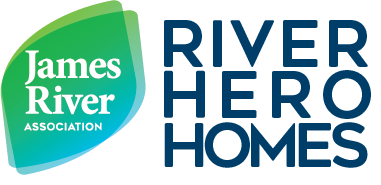River Friendly Practices
What our River Hero Homes are doing:
1. Picking up after their dog
Why? Pet waste carries bacteria, such as E. Coli, that is washed into our waterways during rain or snow storms.
How? It’s simple…when you let your dog out to do his or her business, follow these 3 steps:
1. Take a bag with you, 2. Use the bag to pick up the waste, 3. Toss it in the trash!
2. Reduce herbicide and pesticide use.
Why? Herbicides and pesticides are designed to kill unwanted weeds and insects, but can be harmful to animals and people if not used properly. People rely on the James River, wells, and reservoirs for drinking water so it is important to ensure that they stay as clean as possible.
How? Proper plant selection and maintenance is the best way to avoid unwanted pests and weeds. Weed by hand and reduce the opportunity for weeds by filling in the bare areas in your garden or yard with the desired grass seed or plant. Identify the cause for the damage to the plant before assuming it is a pest. Poor growing conditions or the wrong plant in the wrong place can make the plant more susceptible to pest problems, so assess your situation before turning to pesticide. Talk to your local Virginia Cooperative Extension agent for advice if you are dealing with a pest.
3. Use native plants
Why? Native plants naturally occur in the region in which they evolved. They are adapted to local soil, rainfall and temperature conditions, and have developed natural defenses to many insects and diseases. Invasive species are fast spreading and displace native species, reduce wildlife habitat and alter natural processes.
How? You can use native plants the same way would you landscape with any other plant by simply substituting a non-native species with a similar native species. If you have a larger area, lawn can be replaced with a native meadow. Creating a specific habitat for birds or pollinators require specific species that support their life cycle. Whatever vision you have for your garden, native plants can easily be worked into any design.
4. Conserve water
Why? Using rain barrels or other rainwater harvesting systems, are a simple and often inexpensive way to help reduce the amount of stormwater and nonpoint source pollution leaving your property. By installing one rain barrel, the average homeowner can collect over 1,500 gallons of water per year!
How? The easiest alternative to municipal drinking water is a rain barrel, which collect rainwater from rooftops and store for later use. They come in a variety of types and sizes. The water can be used for irrigation, watering plants, or washing your car. Relatively easy to install, rain barrels are usually made from 55 gallon barrels connected to your home’s downspout.
5. Reduce fertilizer use
Why? One of the biggest problems facing the James River is stormwater runoff, particularly the Nitrogen and Phosphorous that come with it from sources like fertilizers from our lawns. When you have excess of these nutrients, they produce too much growth, particularly algal blooms, that can block sunlight to our underwater grasses. As the algae dies, they decrease oxygen creating “dead zones” that can harm the critters that live in the James River and the Chesapeake Bay. Healthy soil creates happy plants that will not need as much, or any, fertilizer.
How? One of the best ways to improve the structure of your soil is to top-dress your lawn and garden with 1/4” of fine compost at least once a year, preferably between September and November or in early spring. Compost is full of life and improves drainage, reduces pest and disease problems, attracts the good insects and worms, nourishes your soil with important nutrients, which reduces the need for fertilizer, and also helps your soil retain moisture. Mulch is also important for the health of your plants, particularly if you do not have a healthy groundcover. It will help retain moisture, reduce weeds, and will nourish the soil.
Choose three to become a hero in your community!
Ready to do more?
River Friendly Practices are methods to prevent or reduce sediment, nutrients, and other pollutants carried in stormwater runoff from entering surface or groundwater.
Below are types of river friendly practices that you can install on your property that can make a difference in your community and your river. Check out our glossary of terms for more information!
Rain Barrel
What is it?
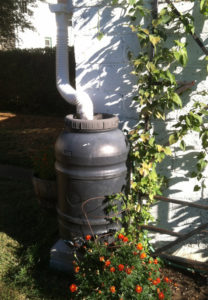 This can include rain barrels, cisterns, or other catchment devices that capture and store a portion of runoff from a roof downspout for non-potable, exterior uses. This water can be used for things like irrigation, watering plants, or washing your car. Capturing and reusing rainwater from your roof not only saves you money on your water bill, but more importantly, it reduces demand on the sewer system and protects the quality of streams and groundwater.
This can include rain barrels, cisterns, or other catchment devices that capture and store a portion of runoff from a roof downspout for non-potable, exterior uses. This water can be used for things like irrigation, watering plants, or washing your car. Capturing and reusing rainwater from your roof not only saves you money on your water bill, but more importantly, it reduces demand on the sewer system and protects the quality of streams and groundwater.
Will it work for me?
Your storage system must be located at the base of one of your downspouts. Choosing the right spot for your rain barrel or cistern depends where you use the water most. The overflow from your rain barrel should be directed to a planting area, rain garden, or other pervious area. If you live in a neighborhood that has a Homeowners Association, please check their requirements.
Resources
Native Plantings
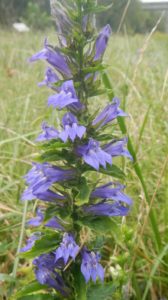 What is it?
What is it?
Native plants naturally occur in the region in which they evolved. They are adapted to local soil, rainfall and temperature conditions, and have developed natural defenses to many insects and diseases. Because of these traits, native plants will grow with minimal use of water, fertilizers, and pesticides. You can incorporate native plantings into a bayscape, rain garden, or vegetated filter strip, use them as your foundation planting, plant a wind break with evergreens, or plant a buffer along the stream that runs through your property.
Will it work for me?
Native plants can be incorporated anywhere in your yard. Pay attention to areas that receive full sun or full shade and dry or wet areas. If the northwest side of your home is wide open, then consider planting a wind break to block the cold winter winds. Make sure that you select the right plant for the right place. If you have a large amount of lawn, replace some of it with native planting beds.
Resources
How to Landscape with Native Plants at Home
BayScapes Homeowners Guide
Tree Planting
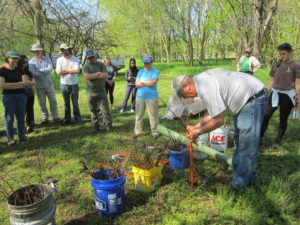 What is it?
What is it?
Trees are important for many reasons. Tree canopies capture and store rainfall and reduce soil erosion by reducing the volume and velocity of rainfall before it reaches the ground. Their roots keep soil in place and the root growth and leaf litter increases soil infiltration. Trees take up large amounts of water from the soil, help reduce ponding issues, and provide important habitat for wildlife. Their shade can also help reduce the cost of cooling your home.
Will it work for me?
If you have open space in your yard then tree planting will probably work for you. Tree roots require a lot of space to grow and if improperly placed, they can damage foundations and paved/concrete areas. Do not plant trees immediately adjacent to structures, such as your house or garage, or adjacent to paved areas including driveways and sidewalks. If you must plant your trees under power lines, make sure you pick species that are low growing.
Resources
Rain Garden
 What is it?
What is it?
A rain garden is a planted depression in the ground that allows rainwater from hard surfaces such as roofs, sidewalks, streets and compacted lawns to be absorbed. This reduces runoff by allowing the water to soak into the ground as opposed to flowing into storm drains, streams and other surface waters.
Will it work for me?
A rain garden is a great place to direct the water from disconnected downspouts and paved areas, or to capture the overflow from a rain barrel. A naturally low spot with good drainage is ideal for a rain garden because water already flows in that direction. Avoid building a rain garden where water ponds for several days because ponding water is a likely indicator that the soil does not drain well. Do not locate the rain garden over a septic system, drain field or underground oil tank unless they have been decommissioned.
Resources
Riparian/Streamside/Shoreline Buffer
What is it?
Riparian/streamside/shoreline buffer is an area along a stream, river, or shoreline that contains a mix of trees, shrubs, and other vegetation. These buffers help to control bank erosion, filter sediment and pollutants, create shade along stream corridors to maintain a cooler water temperature for fish, and they provide wildlife habitat.
Will it work for me?
If you live along a stream or river then this would be applicable. If there is no buffer currently, then the first thing to do is to stop mowing to the edge of the waterway and from here you can add additional plants. If a buffer already exists then you can add additional plants to diversify with small flowering trees or shrubs along the visible edge or keep it the way it is. If there is severe erosion then you should get professional assistance to help stabilize the bank before planting.
Resources
Septic System Maintenance
What is it?
A septic system is a mini wastewater treatment plant for your home. When you flush a toilet, take a bath or do laundry, all of that water and waste has to go somewhere, and if your home has a septic tank, that is where it goes. Proper care is essential to keep your septic system functioning correctly. Malfunctioning septic systems can lead to excess nutrients and wastewater entering the ground water and/or surface water, which is a threat to the health of our streams and rivers, as well as the health of you and your neighbors.
Proper care of your septic system is crucial to avoid excess nutrients and bacteria from entering the ground water and/or surface water. Malfunctioning septic systems can cause major threats to the health of our streams and rivers, as well as the health of you and your neighbors.
- Do not use excessive amount of water in short periods of time and install water saving fixtures when possible
- Do not plant water loving plants, vegetables, or place mulch on top of drainfield. A grass lawn is the best thing to have on top of your drainfield
- Be mindful of what goes down your drain and into your garbage disposal
Will it work for me?
If you have a septic system on your property, then you should have it cleaned and inspected every 5 years. Certain situations, like large families, high water usage or multiple tanks will require more frequent cleaning. If you have a garbage disposal you should have your septic system cleaned every 1-3 years. By following these general rules and taking care of any issues found, you will be doing your part for clean water.
Resources
Septic Systems and Drainfields
Why cleaning your septic system is important.
Smart Yard/Lawn/Garden Maintenance
What is it?
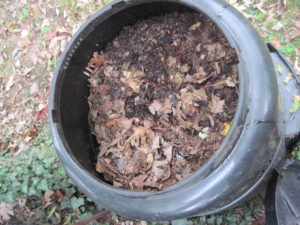 The way that we maintain our yards and gardens can have a great impact on the James River. By reducing fertilizer needs, proper lawn care, watering properly, and composting, you will have healthier plants with less polluted runoff flowing into the James River.
The way that we maintain our yards and gardens can have a great impact on the James River. By reducing fertilizer needs, proper lawn care, watering properly, and composting, you will have healthier plants with less polluted runoff flowing into the James River.
Will it work for me?
With these actions you can save money, have a healthier lawn and garden, and do your part in keeping sediment and excess nutrients from entering the James River.
- Don’t fertilize; if you do fertilize, test your soil first and fertilize at the correct time of year
- If you use a lawn maintenance company, make sure they are environmentally friendly
- Mow high and leave clippings in place
- Compost garden and kitchen waste and/or use compost on your lawn and garden
- Reduce/eliminate the use of herbicides/pesticides. Alternatively, use organic/natural methods
- Water your lawn and/or garden slow and deep
- Time your watering and water only in the morning or late afternoon
- Install a smart irrigation system
- Aerate your yard
- Redirect downspout to a pervious surface


